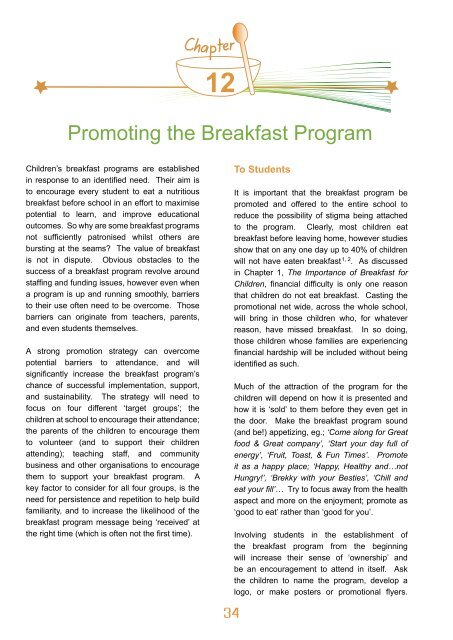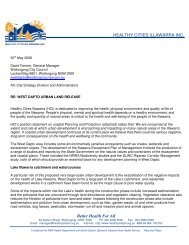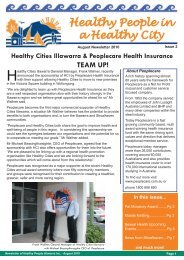here - Healthy Cities Illawarra
here - Healthy Cities Illawarra
here - Healthy Cities Illawarra
Create successful ePaper yourself
Turn your PDF publications into a flip-book with our unique Google optimized e-Paper software.
Chapter<br />
12<br />
Promoting the Breakfast Program<br />
Children’s breakfast programs are established<br />
in response to an identified need. Their aim is<br />
to encourage every student to eat a nutritious<br />
breakfast before school in an effort to maximise<br />
potential to learn, and improve educational<br />
outcomes. So why are some breakfast programs<br />
not sufficiently patronised whilst others are<br />
bursting at the seams? The value of breakfast<br />
is not in dispute. Obvious obstacles to the<br />
success of a breakfast program revolve around<br />
staffing and funding issues, however even when<br />
a program is up and running smoothly, barriers<br />
to their use often need to be overcome. Those<br />
barriers can originate from teachers, parents,<br />
and even students themselves.<br />
A strong promotion strategy can overcome<br />
potential barriers to attendance, and will<br />
significantly increase the breakfast program’s<br />
chance of successful implementation, support,<br />
and sustainability. The strategy will need to<br />
focus on four different ‘target groups’; the<br />
children at school to encourage their attendance;<br />
the parents of the children to encourage them<br />
to volunteer (and to support their children<br />
attending); teaching staff, and community<br />
business and other organisations to encourage<br />
them to support your breakfast program. A<br />
key factor to consider for all four groups, is the<br />
need for persistence and repetition to help build<br />
familiarity, and to increase the likelihood of the<br />
breakfast program message being ‘received’ at<br />
the right time (which is often not the first time).<br />
To Students<br />
It is important that the breakfast program be<br />
promoted and offered to the entire school to<br />
reduce the possibility of stigma being attached<br />
to the program. Clearly, most children eat<br />
breakfast before leaving home, however studies<br />
show that on any one day up to 40% of children<br />
1, 2<br />
will not have eaten breakfast . As discussed<br />
in Chapter 1, The Importance of Breakfast for<br />
Children, financial difficulty is only one reason<br />
that children do not eat breakfast. Casting the<br />
promotional net wide, across the whole school,<br />
will bring in those children who, for whatever<br />
reason, have missed breakfast. In so doing,<br />
those children whose families are experiencing<br />
financial hardship will be included without being<br />
identified as such.<br />
Much of the attraction of the program for the<br />
children will depend on how it is presented and<br />
how it is ‘sold’ to them before they even get in<br />
the door. Make the breakfast program sound<br />
(and be!) appetizing, eg.; ‘Come along for Great<br />
food & Great company’, ‘Start your day full of<br />
energy’, ‘Fruit, Toast, & Fun Times’. Promote<br />
it as a happy place; ‘Happy, <strong>Healthy</strong> and…not<br />
Hungry!’, ‘Brekky with your Besties’, ‘Chill and<br />
eat your fill’… Try to focus away from the health<br />
aspect and more on the enjoyment; promote as<br />
‘good to eat’ rather than ‘good for you’.<br />
Involving students in the establishment of<br />
the breakfast program from the beginning<br />
will increase their sense of ‘ownership’ and<br />
be an encouragement to attend in itself. Ask<br />
the children to name the program, develop a<br />
logo, or make posters or promotional flyers.<br />
34













